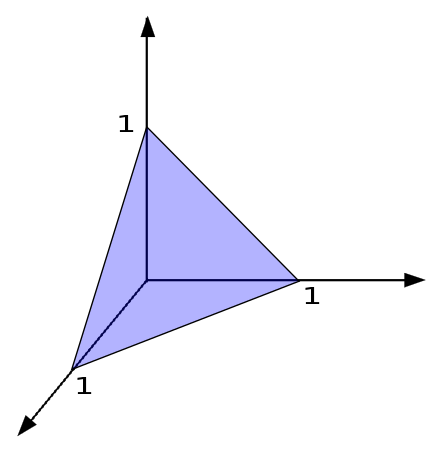Multiple tetrahedra?
⎩ ⎪ ⎪ ⎪ ⎪ ⎪ ⎪ ⎪ ⎪ ⎪ ⎪ ⎪ ⎪ ⎪ ⎨ ⎪ ⎪ ⎪ ⎪ ⎪ ⎪ ⎪ ⎪ ⎪ ⎪ ⎪ ⎪ ⎪ ⎧ x + y + z = 1 x + y + z = 6 x − y − z = 1 x − y − z = 6 y − z − x = 1 y − z − x = 6 z − y − x = 1 z − y − x = 6
The above equations define planes in 3 space.
How many ways can you choose four of them so that the enclosed region defines a regular tetrahedron?

Image credit: Wikiwand
This section requires Javascript.
You are seeing this because something didn't load right. We suggest you, (a) try
refreshing the page, (b) enabling javascript if it is disabled on your browser and,
finally, (c)
loading the
non-javascript version of this page
. We're sorry about the hassle.
1 solution
I think a much better way of presenting this solution is as follows:
- Claim: A (regular) tetrahedron is formed by 4 planes if and only if {insert condition here}
- From the conditions, this implies that we must have X.
For example, in your solution, it doesn't (yet) explain why no other combination of 4 planes would work.
Log in to reply
There I've cleaned it up a bit.
Log in to reply
Great! You can now use "regular tetrahedron" everywhere in the solution.
Four planes enclose a regular tetrahedron if:
For the planes above, the first two are parallel, the third and fourth are parallel, the fifth and sixth are parallel, and the seventh and eighth are parallel, and, no two parallel planes can be part of of four that form the boundary of a regular tetrahedron.
However, it just so happens, that for the planes above, if you choose any two that aren't parallel, the dihedral angle between them is arccos ( 3 1 ) .
So, you will get a regular tetrahedron if you pick the four planes as follows:
Therefore, there are 2 ⋅ 2 ⋅ 2 ⋅ 2 = 2 4 ways of choosing these planes which will enclose a regular tetrahedron.